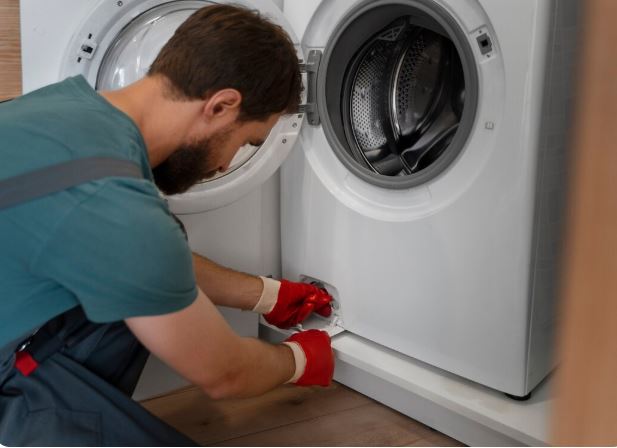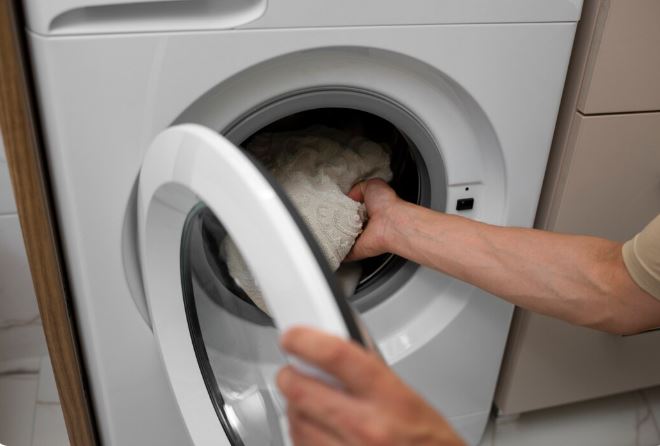Your laundry room has suddenly transformed into an airport runway. That once-quiet LG washer now generates enough noise to drown out conversations, rattle windows, and make you seriously question whether something’s about to launch into orbit.
When your washing machine mimics aircraft turbines during what should be a routine spin cycle, it’s more than just annoying. It’s a mechanical distress signal demanding immediate attention.
This roaring, whooshing phenomenon affects both seasoned machines and brand-new units fresh from the showroom floor, and understanding why it happens is your first step toward restoring peaceful laundry days.

In short, here’s why your LG washer sounds like a jet engine:
An LG washer that sounds like a jet engine typically indicates extreme vibration from unbalanced loads, failed shock absorbers allowing excessive drum movement, shipping bolts left installed on new machines, worn drum bearings creating resonant frequencies, compromised suspension systems, or pump cavitation during drainage. The jet engine sound results from high-velocity airflow and vibration amplification through the washer cabinet.
Jet Engine Sound Severity Assessment
| Sound Intensity | Typical Cause | Machine Status | Action Timeline |
| Moderate roar during high spin | Normal operation at 1,200+ RPM | Functioning normally | No action needed |
| Loud whooshing with vibration | Unbalanced load distribution | Temporary issue | Redistribute immediately |
| Continuous roaring all cycles | Shock absorber failure | Mechanical failure | Repair within 1 week |
| Extreme noise with movement | Shipping bolts installed | Installation error | Fix immediately |
| Roaring with grinding undertones | Bearing failure progression | Severe damage | Stop using now |
| Intermittent jet-like bursts | Pump cavitation or air locks | Moderate concern | Investigate within days |
Understanding the Jet Engine Phenomenon
The comparison to jet engines isn’t mere hyperbole when your LG washer reaches certain failure states. The acoustic similarity stems from shared physical principles.
Jet engines generate sound through high-velocity air movement and turbine vibration. Your washing machine creates similar conditions when mechanical problems allow excessive movement and airflow patterns.
Modern LG washers spin at remarkable speeds. High-efficiency models reach 1,200-1,400 RPM during final spin cycles. At these velocities, even minor imbalances create significant centrifugal forces.
The washer cabinet acts as a resonance chamber. When internal components vibrate at specific frequencies, the metal cabinet amplifies these vibrations exponentially. This amplification transforms modest mechanical noise into overwhelming roars.
Front-loading washers are particularly susceptible to jet engine sounds. Their horizontal drum orientation creates different vibration patterns than top loaders. The drum’s rotational plane aligns with cabinet walls, maximizing vibration transmission.
Sound propagation through your home’s structure matters significantly. Washers installed on upper floors transmit vibration through floor joists. Hollow spaces beneath washers act as amplification chambers, broadcasting noise throughout your home.
The “jet engine” descriptor typically emerges when multiple factors converge. Rarely does a single component create this extreme acoustic signature. Instead, cascading failures or installation errors combine to produce runway-level noise.
New LG Washer Sounds Like a Jet Engine
Nothing frustrates homeowners more than a brand-new appliance malfunctioning immediately. When your fresh-from-the-store LG washer sounds like it belongs at an airfield, specific installation issues are usually responsible.
Transit Bolts Creating Catastrophic Noise
Shipping bolts represent the single most common cause of jet engine sounds in new washers. These heavy-duty fasteners secure the drum during transportation preventing damage from shock and vibration.
Every LG front-loader ships with three to four transit bolts installed on the rear panel. These bolts lock the suspension system completely rigid. They transform the floating drum assembly into a solid unit that can’t absorb movement.
When you operate a washer with shipping bolts installed, the drum attempts to spin but can’t move naturally. The locked suspension creates violent vibration that resonates through the entire cabinet. The result sounds exactly like a jet engine at full throttle.
Locate shipping bolts on your washer’s rear panel. They’re large diameter bolts with plastic spacers positioned at drum height. You’ll need a wrench or socket set for removal.
Remove each bolt by turning counterclockwise. Pull the bolt completely out along with its plastic spacer sleeve. Some models include plastic caps to cover the resulting holes for aesthetic purposes.
Store shipping bolts in a safe location. You’ll need them if you ever move the washer. Reinstalling these bolts before transportation prevents expensive drum and suspension damage.
The transformation after bolt removal is dramatic. Your deafening jet engine sound disappears instantly. The washer operates at its designed whisper-quiet performance level.

Packaging Material Interference
Manufacturers use extensive packaging to protect washers during shipping. Foam blocks, cardboard inserts, and plastic ties secure various components. Overlooking these items creates serious operational problems.
Check between the drum and outer tub for packaging materials. Shine a flashlight through the drum holes examining the space carefully. Look for white foam blocks or cardboard pieces.
Top-loading models sometimes include foam blocks beneath the agitator or surrounding the drum base. These blocks prevent vertical drum movement during transit but must be removed before use.
Zip ties and plastic bands may secure hoses or wiring during shipping. These restraints prevent damage but can interfere with normal component movement during operation.
Review your owner’s manual’s installation section thoroughly. LG provides detailed diagrams showing every packaging item requiring removal. Cross-reference this list against your actual washer.
Forgotten packaging creates interference that forces components to work against unintended resistance. This struggle generates excessive noise and risks permanent damage to motors or suspension systems.
Improper Floor Installation Surface
Your washer’s foundation affects operational noise dramatically. New machines reveal installation surface problems immediately through excessive sound generation.
Soft flooring materials like vinyl planks or laminate lack the rigidity washers need. These surfaces flex during spin cycles, amplifying vibration instead of dampening it.
Wooden floors over crawl spaces create acoustic chambers beneath your washer. The hollow space acts like a speaker cabinet, broadcasting vibration throughout your home’s structure.
Test your installation surface by jumping firmly next to the washer. If you feel significant floor movement or see the washer wobble, your foundation is inadequate.
Ideal washer placement uses concrete slabs or reinforced floors. These rigid surfaces absorb vibration preventing transmission to surrounding structures.
Install anti-vibration pads under each washer foot. These dense rubber pads isolate the machine from floor surfaces reducing noise transmission by 40-60%.
Consider a vibration isolation platform for washers on problematic floors. These platforms combine rubber isolation with rigid panels distributing weight evenly.
Factory Calibration Requirements
Some LG models require calibration mode operation before first use. This process teaches the control board about load sensing and balance detection parameters.
Skipping calibration causes the machine to operate with incorrect baseline assumptions. The washer may spin at improper speeds or fail to detect balance issues accurately.
Access calibration mode using specific button combinations. The exact sequence varies by model but typically involves pressing and holding multiple buttons simultaneously.
Your owner’s manual provides calibration instructions specific to your model. The process takes 3-5 minutes and runs the drum through various speed profiles.
During calibration, the washer spins the empty drum while sensors measure rotation characteristics, balance responses, and vibration patterns. The control board stores this baseline data.
Perform calibration whenever you move the washer to a new location. Transportation and reinstallation change the machine’s relationship with its environment requiring fresh baseline measurements.
Improper Leveling Creating Instability
Unlevel washers experience extreme vibration during spin cycles. The drum’s center of gravity shifts as it rotates, creating forces that amplify when the machine tilts.
Place a bubble level across your washer’s top surface running front-to-back. Repeat the measurement side-to-side. The bubble should rest in the center zone for both orientations.
Adjust front leveling feet by turning them clockwise to raise or counterclockwise to lower the corresponding corner. Most LG washers use easily accessible leveling feet requiring no tools.
Rear legs on LG front-loaders are self-adjusting in many models. Tilt the entire washer forward slightly and allow it to settle back down. The rear legs automatically adjust to the correct height.
Verify leveling after adjustment by forcefully pushing each corner of the washer. A properly leveled machine resists rocking and returns immediately to stable position.
Lock leveling feet once proper level is achieved. Many feet include jam nuts that prevent the adjustment from changing during operation. Tighten these nuts firmly.
Re-check level monthly during the first year. New machines can settle as internal components seat and floor surfaces compress under concentrated weight.

Why Does My Front Load Washer Sound Like a Jet Engine
Front-loading washers have architectural characteristics that make them prone to jet engine acoustics when mechanical systems fail or wear.
Horizontal Drum Dynamics
Front loaders spin drums horizontally unlike top-loaders’ vertical orientation. This fundamental design difference creates unique vibration patterns and sound transmission characteristics.
Horizontal drums distribute weight across side-mounted bearings. These bearings experience constant radial loading throughout rotation. Vertical drums spread bearing load differently across the bearing surface area.
The horizontal configuration positions the drum’s rotational plane perpendicular to gravity. This orientation allows more pronounced side-to-side movement when suspension systems weaken.
Cabinet walls in front loaders run parallel to the drum’s rotation plane. Vibration transmits directly into these large flat panels. The panels act as speaker diaphragms broadcasting noise outward.
Front-loader doors represent another noise transmission path. The large glass door vibrates sympathetically with cabinet resonance, contributing additional acoustic output.
Shock Absorber System Failure
Front-loading washers rely heavily on hydraulic shock absorbers to control drum movement. These shocks work constantly throughout every cycle, experiencing significant mechanical stress.
Each shock contains a piston moving through hydraulic fluid. Internal seals maintain fluid pressure creating dampening resistance. As seals wear, fluid leaks past the piston reducing dampening effectiveness.
Failed shocks allow the drum to oscillate wildly during spinning. The drum swings back and forth within the cabinet striking or nearly striking the outer walls. Each impact creates tremendous noise.
The jet engine sound from shock failure combines multiple acoustic elements. Metal-on-metal impacts, cabinet resonance, and rushing air displaced by the swinging drum all contribute to the overwhelming roar.
Test shock absorbers by forcefully pushing down on the front of an empty drum. Release quickly. The drum should resist your push firmly and return smoothly without bouncing.
Weak shocks offer little resistance to manual pushing. The drum continues bouncing after release rather than stopping immediately. This excessive movement indicates shock replacement necessity.
Front loaders typically use two or four shocks depending on drum capacity. All shocks must be replaced simultaneously. Mixing old and new shocks creates uneven dampening causing continued problems.
Quality replacement shock sets cost $80-150. Professional installation adds $120-200 to the total. DIY installation is possible but requires significant disassembly including cabinet panel removal.
Drum Bearing Catastrophic Wear
Bearings support your drum’s weight while allowing smooth rotation. Front-loader bearings face constant stress from horizontal drum orientation and centrifugal forces during high-speed spinning.
Early bearing failure produces grinding sounds. As deterioration advances, the bearing clearances increase allowing excessive drum play. This play permits the drum to vibrate at resonant frequencies.
The transition from grinding to jet engine roar marks advanced bearing failure. The drum oscillates so severely it creates rushing air sounds as it displaces air within the cabinet.
Bearing-related jet engine sounds are progressive. The noise begins quietly, increases gradually over weeks or months, and eventually becomes unbearable during every cycle.
Inspect bearing condition by grabbing the drum rim and pulling forcefully toward you. Healthy bearings permit minimal movement. Worn bearings allow visible drum displacement of half an inch or more.
Listen carefully during manual drum rotation. Bearing failure creates audible roughness, clicking, or grinding perceptible when spinning the drum slowly by hand.
Water intrusion accelerates bearing failure dramatically. Failed drum seals allow wash water to reach bearings, washing away lubricants and introducing corrosive minerals.
Bearing replacement represents one of the most expensive washer repairs. Professional service costs $350-550 including parts and labor. The repair requires complete drum removal and specialized pressing tools.
Suspension Spring Degradation
Front-loading drums hang from heavy-duty suspension springs or rods. These components maintain drum position and absorb movement during operation.
Springs experience constant tension throughout the washer’s life. Metal fatigue gradually reduces spring tension. Eventually, springs stretch beyond design specifications or break completely.
Weakened suspension allows excessive vertical drum movement. During spinning, centrifugal forces pull the drum in various directions. Inadequate suspension fails to control this movement.
The resulting drum oscillation creates jet engine acoustics. Air rushes past the rapidly moving drum. The drum impacts suspension stops creating loud banging. Cabinet resonance amplifies these sounds.
Inspect suspension springs by tilting the washer and examining components through the bottom access area. Count all springs—most models use three or four—checking each for integrity.
Look for stretched coils, broken wire, or detached mounting points. Measure spring length comparing to service manual specifications if available.
Continuing operation with broken suspension springs damages multiple systems. The uncontrolled drum strikes the outer tub, cabinet walls, and door assembly. Secondary damage costs exceed suspension repair exponentially.
Replacement spring sets cost $60-120 depending on model. Installation requires lifting or supporting the drum assembly to relieve spring tension during removal and installation.

Load Imbalance Amplification
Front loaders are more sensitive to load imbalance than top-loading designs. The horizontal drum allows loads to cluster on one side creating significant weight imbalances.
During spin cycles, imbalanced loads create powerful centrifugal forces pulling the drum toward the heavy side. Modern washers detect this and attempt to redistribute loads by stopping and restarting.
When redistribution fails, the washer may proceed with spinning despite the imbalance. The resulting oscillation creates extreme vibration and jet engine-like roaring.
Single heavy items cause the worst imbalances. Bath mats, comforters, and sleeping bags absorb enormous water quantities becoming extremely heavy on one drum section.
Prevent imbalance issues by mixing heavy and light items in each load. Include several small garments with each large item distributing weight more evenly.
Avoid washing single heavy items alone. Add towels or other similarly sized items to improve weight distribution across the drum surface.
Load capacity ratings exist for good reason. Exceeding capacity by cramming too many items creates compacted loads that can’t redistribute naturally during spin cycles.
Persistent unbalanced load errors despite proper loading practices indicate suspension or leveling problems. The washer cannot effectively redistribute loads when mechanically compromised.
Pump Cavitation During Drainage
The drain pump evacuates water from the tub during and after wash cycles. Under certain conditions, this pump creates jet engine-like sounds through a process called cavitation.
Cavitation occurs when the pump attempts to move water faster than the drain system supplies it. Vacuum pockets form in the pump chamber. When these voids collapse, they create loud popping and roaring sounds.
Partial drain blockages cause most cavitation problems. The pump works harder drawing water through restricted passages. The increased suction creates pressure differentials leading to cavitation.
Check your drain pump filter for blockages. This filter typically sits behind a small access door on the front-loader’s lower front panel. Remove debris, lint, and foreign objects.
Inspect the drain hose for kinks, compression, or internal blockages. The hose should maintain consistent diameter throughout its length without restrictions.
Standpipe height affects drainage efficiency. Your drain connection should be 36-96 inches above floor level. Improper height creates drainage problems causing pump strain.
Air locks in the drain system also cause cavitation-like sounds. These occur when air becomes trapped in drain lines preventing smooth water flow.
Replace drain pumps showing signs of impeller damage or bearing wear. Strange sounds during drainage cycles typically indicate pump problems requiring replacement. New pumps cost $40-90 plus installation time.
Diagnostic Steps to Identify Your Jet Engine Source
Systematic troubleshooting isolates the specific cause of your jet engine acoustics efficiently.
- Start with the absolute basics. Check for shipping bolts if your washer is new. Remove all packaging materials from visible areas. Confirm proper leveling using a bubble level.
- Run an empty spin cycle at the highest speed setting. Listen carefully to sound characteristics. Does the roar occur throughout spinning or only at specific speeds?
- Load the washer with a small balanced load—perhaps six bath towels. Run another spin cycle. Compare sound levels to the empty cycle. Dramatic improvement suggests load distribution issues.
- Manually test mechanical components with power disconnected. Push and pull the drum in various directions. Excessive movement indicates suspension or bearing problems.
- Open the door during a quiet moment. Listen to the machine’s ambient sounds. Control boards, valves, and motors make subtle sounds. Sudden loud roaring during cycles indicates mechanical rather than electrical issues.
- Record video with audio during problem cycles. This documentation helps technicians diagnose issues even if the washer doesn’t replicate problems during service visits.
- Isolate vibration transmission. Place your hand gently on different washer surfaces during spinning. Feel where vibration seems strongest. This identifies the path of noise transmission.
- Check surrounding connections. Sometimes adjacent items vibrate sympathetically with the washer. Shelves, bottles, or nearby appliances create secondary noise sources.

Sound Dampening While Awaiting Repairs
When jet engine noise requires professional repair but immediate service isn’t available, temporary measures like these ones reduce acoustic impact.
- Relocate laundry operations to off-peak hours. Early morning or evening washing minimizes disruption to daily activities and neighborhood peace.
- Close laundry room doors during operation. Solid doors block significantly more sound than hollow-core alternatives. Add weatherstripping around door frames for additional acoustic isolation.
- Place thick blankets or moving pads against walls adjacent to the washer. These absorptive materials prevent sound reflection reducing overall noise levels in surrounding areas.
- Run partial loads at reduced spin speeds if your washer allows manual speed selection. Lower RPMs generate less vibration and correspondingly less noise.
- Install temporary anti-vibration pads if not already present. Even basic rubber mats help isolate vibration preventing transmission through floor structures.
- Inform household members and close neighbors about the temporary situation. Managing expectations reduces frustration while you arrange professional repairs.
- Never ignore jet engine sounds hoping they’ll resolve spontaneously. These acoustic warnings indicate real mechanical problems that worsen with continued operation.
Professional Intervention Decision Points
Certain jet engine sound scenarios demand professional service rather than DIY troubleshooting.
Bearing-related roaring requires professional repair. The disassembly complexity and specialized pressing tools exceed typical homeowner capabilities.
Multiple simultaneous problems suggest cascading failures. Professional diagnosis identifies all affected components preventing incomplete repairs.
If you’ve addressed obvious causes without success, technician experience proves invaluable. They’ve encountered similar problems hundreds of times and recognize subtle diagnostic clues.
Error codes accompanying jet engine sounds indicate control system involvement. Electrical diagnostics require specialized equipment and manufacturer-specific knowledge.
Warranty coverage mandates authorized service. DIY repairs void warranty protection leaving you financially responsible for all future problems.
Schedule mobile diagnostic appointments for $80-150 depending on your location. Technicians identify exact problems and provide detailed repair cost estimates before beginning work.
Consider machine age when deciding between repair and replacement. Expensive repairs on washers exceeding ten years old may not offer good value compared to new energy-efficient models.
Preventive Strategies for Silent Operation
Proactive maintenance prevents many conditions that lead to jet engine acoustics. That includes doing the following:
- Maintain proper load distribution in every cycle. Mix heavy and light items. Avoid single-item washing. Respect capacity limits.
- Clean the drain pump filter monthly. Remove accumulated lint, coins, and debris before they restrict water flow causing pump strain.
- Wipe door seals weekly removing moisture and residue. This prevents premature seal deterioration that leads to water intrusion and bearing damage.
- Use high-efficiency detergent in recommended quantities. Excess suds create residue buildup on suspension components and seals accelerating deterioration.
- Run monthly maintenance cycles with the best washing machine cleaner (View on Amazon). These products dissolve mineral deposits and detergent accumulation preventing corrosion.
- Leave doors open between cycles allowing interior moisture evaporation. Reduced humidity exposure slows metal corrosion and rubber seal degradation.
- Verify proper leveling quarterly. Settling floors or shifting appliances change level over time. Quick checks prevent cumulative damage from persistent unlevel operation.
- Inspect visible components during routine cleaning. Look for loose fasteners, worn hoses, or unusual residue patterns indicating developing problems.
- Install whole-house water softeners (View on Amazon) if your water hardness exceeds 120 ppm. Soft water prevents mineral accumulation that corrodes bearings and suspension components.
- Avoid overloading consistently. Operating at maximum capacity regularly stresses components beyond their design optimization point.

Frequently Asked Questions
Is it normal for LG washers to be loud during high-speed spinning?
Modern LG washers produce some operational sound at maximum spin speeds of 1,200-1,400 RPM. However, the sound should resemble a moderate hum or whoosh, not aircraft engines. If neighbors hear your washer through walls or conversation becomes difficult nearby, the noise exceeds normal parameters.
Can jet engine sounds damage my LG washer further?
The underlying mechanical problems causing jet engine sounds—not the sounds themselves—create additional damage. Failed shock absorbers allow drum impacts. Worn bearings grind away metal surfaces. Continuing operation accelerates component destruction and increases eventual repair costs significantly.
How much does it cost to fix a washer making jet engine sounds?
Repair costs depend entirely on the root cause. Removing forgotten shipping bolts costs nothing. Shock absorber replacement runs $200-350. Bearing replacement reaches $350-550. Suspension spring repairs cost $150-300. Multiple simultaneous problems can exceed $600 making replacement consideration appropriate.
Why does my washer only sound like a jet engine with certain loads?
Load-specific jet engine sounds indicate balance sensitivity. Large single items or improperly distributed loads create centrifugal forces that overwhelm compromised suspension systems. The same mechanical weakness might not manifest with perfectly balanced small loads demonstrating the wear’s progressive nature.
Will anti-vibration pads fix my jet engine sound problem?
Vibration pads reduce noise transmission but don’t address underlying mechanical failures. They’re excellent preventive measures and helpful temporary solutions. However, failed bearings, broken shocks, or worn suspension components require actual repair. Pads complement repairs but don’t substitute for them.
Should I repair or replace an LG washer making jet engine sounds?
Consider machine age, repair costs, and overall condition. Shock absorber replacement on a 3-year-old washer makes excellent economic sense. Bearing replacement costing $500 on a 10-year-old machine warrants replacement consideration. Compare repair estimates to new energy-efficient model prices.
Can I move my LG washer while it’s making jet engine sounds?
Never move a malfunctioning washer without addressing problems first. Install shipping bolts before any relocation preventing additional damage during transport. Moving a washer with failed bearings or broken suspension risks catastrophic damage. Fix mechanical issues or consult professional movers experienced with appliance transportation.
Clearing the Runway for Peaceful Laundry Days
Your laundry room deserves better acoustics than an international airport. When your LG washer channels its inner Boeing 747, it’s communicating urgent mechanical messages through the universal language of deafening noise.
New washer owners facing immediate jet engine sounds should methodically verify shipping bolt removal, packaging elimination, and proper leveling. These installation oversights account for 70% of brand-new washer noise complaints and resolve within minutes.
Experienced machines developing jet engine characteristics signal genuine component wear. Failed shock absorbers, worn bearings, or degraded suspension systems require professional evaluation and repair. These aren’t problems that improve with time—they escalate with every cycle.
Economic decisions balance repair costs against machine age and condition. Young washers with single-component failures warrant repair investment. Older machines with multiple problems or those requiring expensive bearing replacement deserve replacement consideration.
Don’t normalize excessive noise. Jet engine sounds aren’t quirky personality traits your washer develops. They’re mechanical distress signals warning of active component destruction and impending complete failure.
Address problems promptly preserving your washer’s remaining value. Every cycle with failing bearings compounds damage. Every spin with broken shocks risks drum and cabinet destruction. Early intervention saves money.
Your household deserves the quiet efficiency LG engineered into their washing machines. Restore that peaceful performance.
